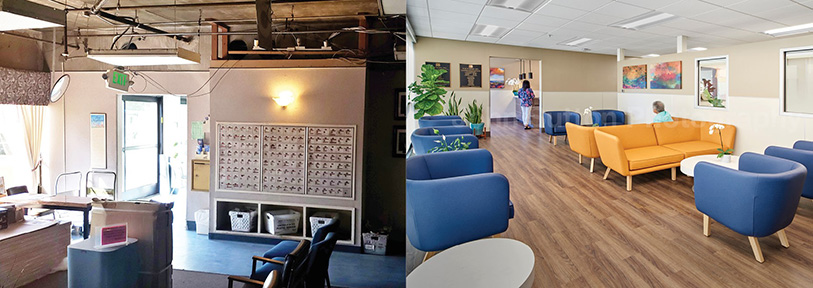At SGPA, we know that learning will always be an essential part of our practice. The direction and trends in architecture are continuously transforming, and it is vital for us to be aware of these perpetual changes. Recently, SGPA’s Associate Principal Pamela Camack co-presented alongside iGroup Design’s Shaynee McMillion at a LeadingAge Region Meeting in San Diego to discuss the emerging trends that are developing in senior living communities. In general, this presentation focused on the design aspects of senior living evolving from healthcare and institutional environments to contemporary and hospitality experiences.
Below are three core aspects that are transforming senior living environments, along with ways that SGPA incorporates these changes into our design and planning for projects with limited budgets.
Amenities
There is a rise in popularity for emphasis on luxury or resort-style experiences in senior living communities. Typically, communities with greater monetary resources offer pool areas, activity rooms, health and fitness centers, exterior gathering spaces, large common areas, multiple dining venues, and salons and spas. The rise in significance for resort-style living is a result of Baby Boomers selecting their parents’ new residency and the importance they place in comfort and convenience. These communities are not only places for seniors to live but also areas for their families to visit and enjoy.
SGPA understands the importance of offering residents the choice of an array of amenities that fit within all project budgets. For projects with smaller budgets, SGPA utilizes space and priorities to facilitate areas where residents can gather and enjoy their communities together. Our Littlejohn Commons project in Alameda, California is one of our affordable senior housing developments that the Alameda Housing Authority recently completed for low-income seniors. Extensive landscaping, community gardens, and a flexible activity space that includes a meeting area, living room, and a kitchenette were all incorporated in this active senior living community. The activity space is utilized by residents for a variety of activities such as yoga, board meetings, movies, and dining, while the community garden provides a space with many benefits including a biophilic connection to the activity space. Residents are able to garden and care for their own plants and vegetables, gather with family and friends, and even just relax and enjoy the fresh air.
 (Littlejohn Commons activity space & garden)
(Littlejohn Commons activity space & garden)
Even with limited budgets, as designers we focus on providing multi-use, flexible amenities for residents of those communities, so their lifestyle is enhanced with opportunities to come out of their apartments to get to know their neighbors, and host guests at their community. Another concept that SGPA uses for projects with budget limitations are the furnishings in outdoor spaces. Rather than implementing large sunshades and permanent furniture, SGPA promotes outdoor space flexibility by providing chairs and umbrellas that are cost effective and relocatable to complement the space.
Planning Concepts
In the past, senior living communities were predominantly developed in suburban neighborhoods, but now there are a growing number of developments located in urban settings. An advantage of urban positioning is the ease of integration into the community. Seniors have convenient access to amenities that the surrounding community offers such as restaurants, theaters, salons, gyms, coffee shops, and museums. New urban senior living developments can save the expense of over amenitizing their buildings and rely on the neighborhood to provide opportunities for these services and activities. An added benefit is that as trends change the facility doesn’t have to renovate underutilized amenity spaces to meet new demands since the neighborhood will do that naturally over time.
One example of a thriving urban senior living community is the recently renovated Fuji Towers in Downtown San Jose. SGPA designed an updated lobby with new furniture and artwork, renovated the community room into a multi-purpose space with meeting areas and a large TV to watch movies. Exterior improvements include all new drought tolerant landscaping and senior-friendly walking paths with ample seating areas with umbrellas for shade. As you can see in the aerial photo below, the project is located close to San Jose’s Japan Town with ample restaurants, cafes, shops, and churches within short walking distances.
 (Fuji Towers aerial view of surrounding area)
(Fuji Towers aerial view of surrounding area)
Renovations
When designing renovations for a project with a limited budget, priority is placed on energy efficient improvements and accessibility enhancements rather than surface attributes such as wallpaper and carpet. The wellbeing of the residents takes precedence to assets of luxury. SGPA not only takes into consideration the property owners’ plans and ideas, but also places a considerable amount of importance on the opinions of the residents. Close collaboration with staff and residents ensures their needs are integrated into the decisions of prioritizing areas of renovations.
 (Fuji Towers, lobby before and after)
(Fuji Towers, lobby before and after)
In summary, senior living communities have grown and evolved for the better and will continue to do so as the next generation of seniors moves into the industry. The interests, needs, and priorities of their tenants have moved more towards resort-style living and drifted away from the institutional environments of the past. Areas of entertainment, exercise, and activities are at the top of the list for most residents – and their Baby Boomer children. Since adult children often play a role in selecting their parents’ new residence, design and amenities need to appeal to both generations.
Our Senior Living | Wellness Studio is made of team members who are passionate about design and are always seeking the latest trends, processes, and ideas. As these trends continue to change, so will SGPA’s design and conceptual planning.
